Students can Download 1st PUC Biology Previous Year Question Paper March 2019 (North), Karnataka 1st PUC Biology Model Question Papers with Answers helps you to revise the complete Karnataka State Board Syllabus and score more marks in your examinations.
Karnataka 1st PUC Biology Previous Year Question Paper March 2019 (North)
Time: 3.15 Hours
Max Marks: 70
General Instructions:
- The question paper consists of four parts A, B, C, and D.
- All the parts are compulsory.
- Draw diagrams wherever necessary. Unlabelled diagrams or illustrations do not attract any marks.
Part – A
Answer the following questions in one word / one sentence each: ( 10 × 1 = 10 )
Question 1.
What is biodiversity?
Answer:
Biodiversity refers to the variety of organisms present on the Earth (species richness).,
Question 2.
Where do you find pneumatophores?
Answer:
In mangrove species.
Question 3.
Write the scientific name of Mango.
Answer:
Mangifera Indica
Question 4.
Where do you find motor cells?
Answer:
In monocot leaf
Question 5.
In which stage of the cell cycle does DNA replication occur?
Answer:
S-phase of interphase.
Question 6.
Define imbibition.
Answer:
Imbibition is a special kind of diffusion that involves the movement of water molecules along a diffusion gradient from a region of higher concentration onto a suitable solid matrix (adsorption).
or
It is the adsorption of water molecules by hydrophilic colloids.
Question 7.
What is nitrogen fixation?
Answer:
The process of conversion of nitrogen into ammonia and/or other nitrogen compounds is known as nitrogen fixation.
Question 8.
Name any one muscle protein.
Answer:
Actin
Question 9.
Mention the type of movement that macrophage exhibit.
Answer:
Amoeboid movement.
Question 10.
Define reflex action.
Answer:
Reflex action is an automatic response to any kind of stimulus without conscious involvement of the brain.
PART-B
Answer any FIVE of the following questions in 3-5 sentences each, wherever applicable. (5 × 2 = 10)
Question 11.
What is binomial nomenclature? Who proposed it?
Answer:
Naming of living organisms by scientific name universally by two names is binominal nomenclature. The two names include generic name and species name. It was Proposed by Carolus Linnaeus.
Question 12.
Name the fungal and algal components of lichens.
Answer:
Chemosynthetic bacteria are autotrophic as they can manufacture organic food from inorganic raw materials, with the help of chemical energy obtained by them by oxidising inorganic chemicals present in their environment.
Question 13.
Mention two types of body forms exhibit by Coelenterata.
Answer:
- Polyp form (asexual reproduction).
- Medusoid form (sexual reproduction).
Question 14.
Earthworms are called “Farmer’s friends.” Justify it.
Answer:
Earthworms are called friends of farmers because they make burrows in the soil and make it porous which helps in respiration and penetration of developing plant roots. The fertility of soil is also increased by their vermicompost.
Question 15.
Differentiate tendons from Ligaments.
Answer:
1. Tendons: They are exclusively composed of white collagenous fibres arranged in regular bundles. In between these fibres, a few fibroblasts may occur. Usually, they connect muscle to bone.
2. Ligaments: They may contain both white and yellow fibres and these fibres are arranged in less orderly patterns. Usually, they connect bone to bone.
Question 16.
Name the two types of lymphocytes responsible for immunity.
Answer:
T and ‘B’ lymphocytes.
Question 17.
Write a note on coronary artery diseases.
Answer:
Atherosclerosis: It is a disease of the arterial wall in which the inner layer becomes thick due to the cholesterol deposition in the form of plaques on the inner lining of the arteries. It is called coronary artery disease (CAD) or ischemic heart disease (IHD).
Question 18.
What is osteoporosis? What is the cause for it?
Answer:
- Amoeboid Movement: Macrophages and Neutrophils.
- Ciliary Movement: Epithelium of nasal tract, urinary tubule and fallopian tube.
PART-C
Answer any FIVE of the following questions in 40 to 80 words each, wherever applicable. (5 × 3 = 15)
Question 19.
Mention any three salient features of class mammalian.
Answer:
- Class Mammalia includes warm-blooded and highly organized animals possessing mammary (mi1k) glands for suckling their young ones. They live almost in all the environments of the world and undergo secondary adaptation to suit their habitats. They are also known as hair quadrupeds.
- Mammals are all homoeothermic (warm-blooded) animals.
- The body shape varies, and ¡Lis covered by hairs.
Question 20.
What is placentation? Mention any two types.
Answer:
The arrangement of ovules within the ovary on a fertile tissue.
Marginal, Axile, Parietal, Basal, Central, Free central.
Question 21.
Write any three differences between prokaryotes and eukaryotes.
Answer:
| Procaryotes | Eucaryotes |
| (a) Primitive and indefinite nucleus | (a) True and definite nucleus |
| (b) Membrane bound organelles are absent | (b) Present |
| (c) 70S types of Ribosomes | (c) 80S type of Ribosomes |
Question 22.
Mention the significance of meiosis.
Answer:
Significance of Meiosis:
- Meiosis brings genetic crossing over and random distribution of paternal and maternal chromosomes to daughter cells.
- Recombination produces variations and varia’Iîons are the sources of organic evolution.
Question 23.
Explain the carbohydrate digestion in the small intestine.
Answer:
a. Digestion in the mouth: The salivary amylase or ptyalin converts starch and glycogen into maltose units.
![]()
b. Digestion in the intestine:
Pancreatic juice: Carbohydrase secreted by the pancreas is called pancreatic amylase. It converts starch and glycogen into maltose units.
![]()
Intestinal juice: It consists of three types of carbohydrates.
Maltase: Maltase catalyses the hydrolysis of maltose (disaccharide) into glucose units (monosaccharides).
![]()
Sucrase: Sucrase catalyses the splitting of sucrose (disaccharide) into glucose, and fructose units (monosaccharides).
![]()
Lactase: Lactase acts on milk sugar lactose (disaccharide), and splits lactose into galactose, and glucose units (monosaccharides).
![]()
Question 24.
Define the following:
(a) Tidal volume
(b) Residual volume
(c) Vital capacity
Answer:
(a) Tidal volume: It is the volume of air inhaled or exhaled with each inhalation and exhalation without any extra effort. Its volume is 500 ml.
(b) Residual volume: It is the volume of air that remains inside the lungs at the end of forceful expiration. Its volume is 1100 – 1200 ml.
(c) Vital capacity: It is. the total volume of air that can be expelled from the lungs during maximum exhalation.
VC = TV+ IRV + ERV
= 500 + 2500 + 1100
= 4100 ml approx.
Question 25.
What are uricotelic animals? Give two examples.
Answer:
Ureotelic animals: Animals that excrete urea are called ureotelic animals. Urea is produced by the liver during the ornithine cycle. Urea is stored in the urinary bladder in a dissolved state called urine.
e.g: Cartilaginous fish (Shark), Mammals and Amphibians.
Question 26.
What is meristem? Mention the types based on position.
Answer:
Meristems are young immature cells capable of cell division.
Based on position, there are mainly three types:
(a) Apical Meristems: They are found at the tip of the stem and root. The activity of this, meristem leads to an increase in length.
(b) Intercalary Meristems: These are found between permanent tissues, at the base of the internode and leaf. The activity of this meristem leads to an increase in the length of the internode.
(c) Lateral Meristems: These are meristem is-situated parallel to the sides of the organs and permanent tissues. Their activity leads to secondary growth.
PART-D (Section – I)
I. Answer any FOUR of the following questions in 200-250 words each, wherever applicable. (4 × 5 = 20)
Question 27.
Write the salient features of kingdom Mycota with two examples.
Answer:
Kingdom -Fungi (Mycota):
Fungi are eukaryotic, achlorophyllous organisms that are but, generally multicellular a few are unicellular (yeast).
- The fungal body consists of long, slender, thread-like structures called hyphae, which form a network called mycelium.
- The hyphae have a cell wall made up of chitin.
- They may be aseptate and multi-nucleate i.e., coenocytic or septate.
- All fungi are heterotrophs -they are saprotrophs or parasites or live as symbionts in the roots of higher plants (mycorrhizae) and in lichens (mycobiont).
- They reproduce vegetatively by fragmentation, fission or budding.
- Asexual reproduction is by the formation of zoospores as in Saprolegnia and Pythium by Aplanospores/sporangiospores formed endogenously (within the sporangium) as in Rhizopus and Mucor or by conidia, which are produced exogenously on the swollen tip of the conidiophore as in Penicillium and Aspergillus.
Question 28.
Give the functions of the following :
(a) Adipocytes
(b) Macrophages
(c) Fibroblasts
(d) Plasma cells
(e) Mast cells.
Answer:
(a) Stores fat
(b) Phagocytosis
(c) Synthesis collagen
(d) Single kind of antibody production
(e) Provide immune tolerance.
Question 29.
Describe the fluid mosaic model of the plasma membrane.
Answer:
Plasma Membrane:
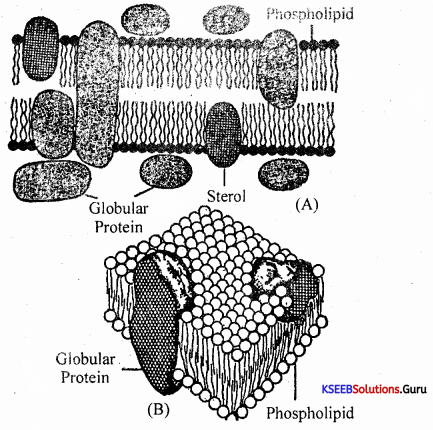
(A) Schematic representation of a section through a eukaryote fluid mosaic membrane.
(B) The fluid mosaic model of Singer and Nicholson (1972)
All living cells are enclosed in a thin, living and selectively permeable membrane called the plasma membrane. Its thickness is about 75 – 100 A Plasma membrane consists of 30 – 40% lipids and 60 – 70% proteins. In animal cells, it surrounds the protoplasm and in plant cells, it is next to the cell wall.
Fluid mosaic Model By Singer & Nicholson:
(a) According to this model, the plasma membrane consists of a double layer of lipid molecules and globular protein molecules and sterols distributed at random. In comparative terms, it can be said that the plasma membrane is formed of ‘protein icebergs in the sea of lipids’.
(b) The protein molecules are globular proteins and these proteins penetrate or lie at the periphery to form a mosaic pattern.
(c) Heads of the phospholipid molecules of the two layers are directed in the opposite directions while tails of the two layers face each other.
(d) In animal cells glycolipids and cholesterol are also present along with proteins.
Question 30.
Describe any five classes of enzymes and the type of reaction they catalyse.
Answer:
Classification of enzymes:
- Oxidoreductases: Act on many chemical groupings to add or remove hydrogen atoms.
- Transferases: Transfer functional groups between donor and acceptor molecules. Kinases are specialised transferases that regulate metabolism by transferring phosphate from ATP to other molecules.
- Hydrolases: Add water across a bond, hydrolyzing it.
- Lyases: Add water, ammonia or carbon dioxide across double bonds, or remove these elements to produce double bonds.
- Isomerases: Carry out many kinds of isomerization: L to D isomerizations. Mutase reactions (shifts of chemical groups) and others.
- Ligases: Catalyze reactions in which two chemical groups are joined (or ligated) with the use of energy from the ATP diagram of stomata and describe the structure.
Question 31.
Draw a labelled diagram of stomata and describe the structure.
Dicot Stomatal Apparatus:
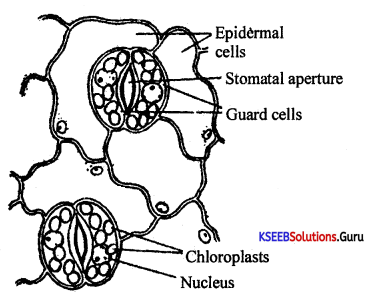
Dicot stomatal apparatus includes,
(a) Stoma: a minute opening present between the guard cells.
(b) Guard cells: Specialised epidermal cells surrounding the stoma. These are two in number and are kidney-shaped. Their outer walls are thin and elastic but inner walls are thick and less elastic.
Question 32.
Explain the process involved in root nodule formation.
Answer:
1.When the root hair of a leguminous plant comes in contact with Rhizobium, it becomes curled or deformed due to the chemicals secreted by the bacterium.
2.The rhizobia enter these deformed root hair and proliferate within the root hair.
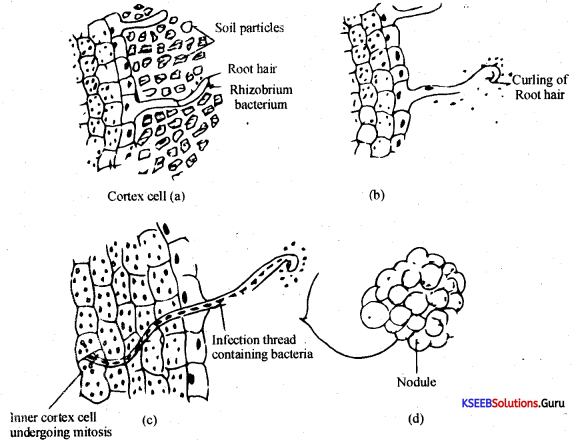
Section – II
II. Answer any THREE of the following questions in 200-250 words each, wherever applicable. (3 × 5 = 15)
Question 33.
Explain the steps involved in glycolysis.
Answer:
- It occurs in the cytoplasm of the cell.
- It is an enzymatic reaction, thus temperature sensitive.
- It is a common reaction for both aerobic and anaerobic respiration.
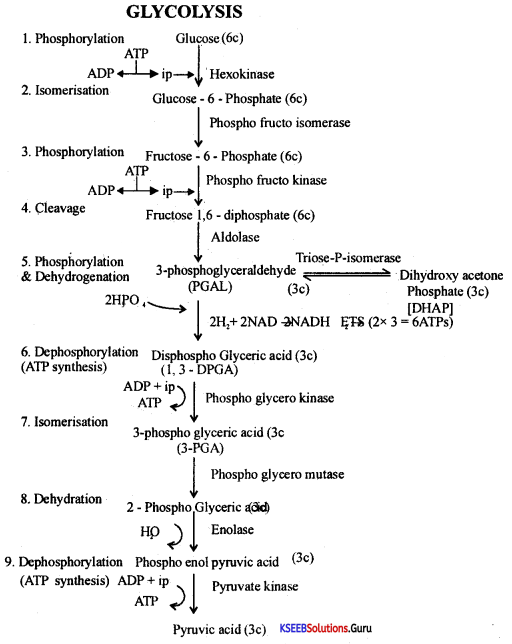
Question 34.
(a) Write any two differences between a long day and short-day plant,
Answer:
- Long Day Plants: These flower in photoperiod more than critical day length, eg: Wheat, oats etc.
- Short Day Plants: These flower in photoperiod less than critical day length.
e. g: Tobacco, Chrysanthemums etc.
(b) Mention the role of Auxins in plants,
Answer:
Auxins
- Auxins can stimulate cell division, cell elongation and cell maturation.
- It promotes Apical dominance.
- It initiates Root formation.
- Can promote parthenocarpy.
- Prevent premature fall of flowers, buds, and leaves.
- 2, 4D, and 2,4,5T are used as selective weedicides.
- Promote phototrophic and hydrotropic movements.
- Promote xylem differentiation.
Question 35.
Draw a labelled diagram of the sagittal section of the human brain.
Answer:
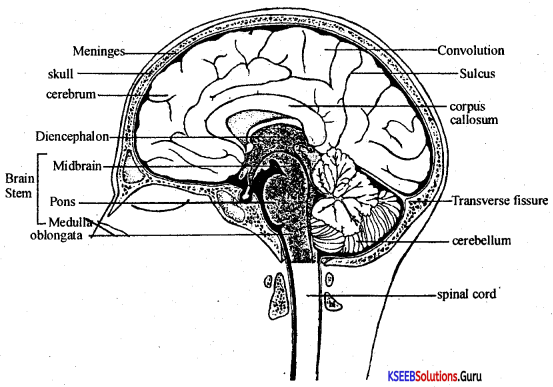
Question 36.
Write the schematic representation of hormonal action.
Answer:
Mechanism of hormone action: Hormones exert their effects on target cells by interacting with specific receptors of these cells. These receptors are proteins or lipoproteins. The location of the hormone receptor depends on the chemical nature of the hormone. The water-soluble hormones (polypeptides, glycoproteins and catecholamines) cannot pass through the plasma membrane, hence their receptors are located on the outer surface of the membrane.
Water-soluble hormone action: The lipophilic hormones (steroids and thyroxine) can pass through the plasma membrane and enter into their target cells, hence the receptors for these hormones are located within the nucleus and cytoplasm.
The water-soluble hormones have their action mediated through second messengers. When these hormones bind to their specific receptors of the plasma membrane specific membrane proteins become activated to generate second messengers
Cyclic AMP, phospholipase C, inositol triphosphate, diacylglycerol and Ca+ act as second messengers.
Cyclic AMP second messenger system has the following sequence of events to affect the action of the hormone.
- The hormone binds to the specific membrane receptor of the target cell.
- G proteins linked to specific receptors activate the enzyme adenylate cyclase.
- Activated adenylate cyclase, converts ATP to cyclic AMP.
- Cyclic AMP activates protein kinase enzymes of the cytoplasm.
- Protein Kinase phosphorylates (adding phosphate groups too) are the other enzymes of the cytoplasm.
- The phosphorylation of specific enzymes may enhance or inhibit their activity.
- This alters the metabolism of the target cell in the required direction as per the specific hormone action.
Lipophilic hormone action:
Mechanism of action of a steroid hormone The lipophilic steroid hormones and thyroid hormones pass through the plasma membrane and get bound to a specific intracellular receptor. These receptors are commonly located within the nucleus. Once these nuclear hormone receptors are activated by their binding to the specific hormones, they alter the gene expression. They may switch on or off specific genes on the nuclear DNA. The transcription of DNA occurs and the newly formed mRNA directs the synthesis of specific enzyme proteins. These enzymes alter the metabolism of the cell in the required direction as per the intended action of the hormone.
Question 37.
Explain any five factors that affect the rate of photosynthesis.
Answer:
Factors affecting photosynthesis:
The following factors influence photosynthesis:
1. Light: Sunlight is used as the primary source of energy. Its three aspects affecting th; process are:
(a) Light Intensity: Optimum light intensity for photosynthesis is 2000-2500 foot candles Higher light intensity bleaches chlorophyll and is called solarisation.
(b) Light Quality: Photosynthetic rate is maximum in red light, next maximum in blue light, and least in green light.
(c) Duration: Photosynthetic rate is more efficient in intermittent light than in continuous light supply.
2. CO2: Used as a raw material in photosynthesis. Its concentration in air is 0.03%. Its increase up to 0.5% increases the rate of the process but above 0.5% inhibits photosynthesis.
3. O2: Liberated as a by-product in photosynthesis. Its increase above the normal 21% in air, decreases the rate of the process. It is called the Warburg effect.
4. Temperature: It affects photosynthesis through its influence on the enzyme controlled dark reaction. The optimum temperature is 18 – 40°C for photosynthesis.
5. Water: Used as a raw material in photosynthesis. In the dehydrated state of cells, photosynthesis is inhibited.